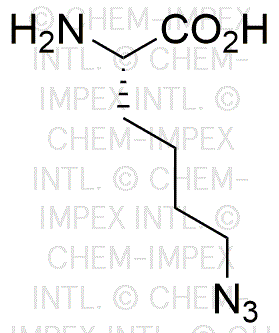6-Azido-L-lysine is widely utilized in research focused on:
- Bioconjugation: This compound serves as a versatile building block for bioconjugation, allowing researchers to attach biomolecules like proteins or antibodies to surfaces or other molecules, enhancing drug delivery systems.
- Click Chemistry: It plays a crucial role in click chemistry reactions, which are used to create complex molecular structures quickly and efficiently, making it valuable in drug discovery and development.
- Protein Labeling: The azido group enables specific labeling of proteins in biological studies, aiding in the visualization and tracking of protein interactions within cells.
- Peptide Synthesis: As a modified amino acid, it is used in peptide synthesis to create novel peptides with unique properties, which can be used in therapeutic applications.
- Research in Neuroscience: It is being explored for its potential in neuroscience research, particularly in studying neuronal signaling and the development of neuroprotective agents.
General Information
Properties
Safety and Regulations
Applications
6-Azido-L-lysine is widely utilized in research focused on:
- Bioconjugation: This compound serves as a versatile building block for bioconjugation, allowing researchers to attach biomolecules like proteins or antibodies to surfaces or other molecules, enhancing drug delivery systems.
- Click Chemistry: It plays a crucial role in click chemistry reactions, which are used to create complex molecular structures quickly and efficiently, making it valuable in drug discovery and development.
- Protein Labeling: The azido group enables specific labeling of proteins in biological studies, aiding in the visualization and tracking of protein interactions within cells.
- Peptide Synthesis: As a modified amino acid, it is used in peptide synthesis to create novel peptides with unique properties, which can be used in therapeutic applications.
- Research in Neuroscience: It is being explored for its potential in neuroscience research, particularly in studying neuronal signaling and the development of neuroprotective agents.
Documents
Safety Data Sheets (SDS)
The SDS provides comprehensive safety information on handling, storage, and disposal of the product.
Product Specification (PS)
The PS provides a comprehensive breakdown of the product’s properties, including chemical composition, physical state, purity, and storage requirements. It also details acceptable quality ranges and the product's intended applications.
Certificates of Analysis (COA)
Search for Certificates of Analysis (COA) by entering the products Lot Number. Lot and Batch Numbers can be found on a product’s label following the words ‘Lot’ or ‘Batch’.
*Catalog Number
*Lot Number
Certificates Of Origin (COO)
This COO confirms the country where the product was manufactured, and also details the materials and components used in it and whether it is derived from natural, synthetic, or other specific sources. This certificate may be required for customs, trade, and regulatory compliance.
*Catalog Number
*Lot Number
Safety Data Sheets (SDS)
The SDS provides comprehensive safety information on handling, storage, and disposal of the product.
DownloadProduct Specification (PS)
The PS provides a comprehensive breakdown of the product’s properties, including chemical composition, physical state, purity, and storage requirements. It also details acceptable quality ranges and the product's intended applications.
DownloadCertificates of Analysis (COA)
Search for Certificates of Analysis (COA) by entering the products Lot Number. Lot and Batch Numbers can be found on a product’s label following the words ‘Lot’ or ‘Batch’.
*Catalog Number
*Lot Number
Certificates Of Origin (COO)
This COO confirms the country where the product was manufactured, and also details the materials and components used in it and whether it is derived from natural, synthetic, or other specific sources. This certificate may be required for customs, trade, and regulatory compliance.


